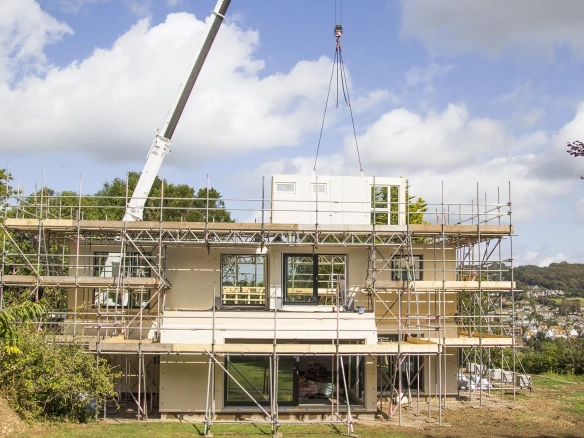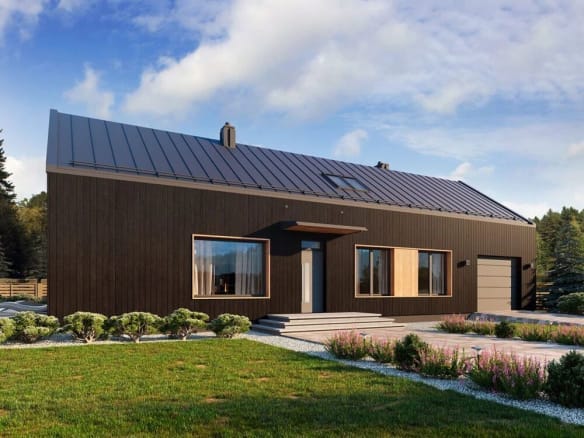12 minutes read
Europe is home to more than 1,000 prefab house manufacturers, but finding the right one isn’t as straightforward as it sounds. Behind the glossy renders and futuristic promises lies a fragmented industry, shaped by regional traditions, sustainability goals, and evolving housing needs.
In this analysis, we’ll break down how many prefab house manufacturers exist in Europe today—and what that means for anyone considering building one.
Intro: The Rise of Prefabricated Construction
Every year, around 1.5 million new homes are built in Europe, according to Euroconstruct research network. Of these, 600,000 are family homes and roughly 12% employ prefabrication systems in their construction — a share that is steadily growing.
The contemporary housing landscape is facing major challenges in Europe and the United Kingdom. Affordability is a growing concern, especially for younger generations priced out of housing markets. At the same time, the construction industry is under pressure to decarbonize, as it remains one of the largest contributors to greenhouse gas emissions worldwide.
Among the main obstacles to addressing construction demands is the shortage of skilled labor. While construction relies on a wide range of trades, finding proficient teams and aligning them efficiently on-site has become increasingly difficult. Add to this the rising cost of materials, and the equation for affordable, sustainable housing becomes nearly impossible to balance.
Conventional building is a complex, multi-step process, requiring the coordination of multiple specialists and trades on-site. Each stage — from foundations to walls to finishes — introduces risks of delays, cost overruns, and inconsistencies in quality. The availability at the project site of expert masons, carpenters, electricians, plumbers, painters, etc. is a challenge and the efficient coordination of these teams implies an added difficulty.
By contrast, prefabrication rethinks construction as a supply chain. Key elements of the building (or the whole house itself) are produced off-site in a factory and then transported for assembly. This ensures standardisation, precision, and efficiency. Similar to other mature industries, the advancement of automation and monitoring in factory environments is providing a clear improvement to construction processes by mitigating the impact of incident-prone external factors like climate.
Prefabricated housing today represents one of the most promising avenues for delivering affordable, sustainable, and high-quality homes at scale. The principal advantages of prefabricated construction include:
- Speed: Faster construction timelines, since much of the work is completed in a controlled factory environment.
- Cost-efficiency: Reduced waste, predictable budgets, and economies of scale.
- Sustainability: Lower carbon footprint through optimized material use and energy efficiency.
- Quality control: Manufacturing in factory settings reduces on-site errors and improves precision.
In short, prefabrication has become an increasing necessity for Europe’s housing future.

What counts as prefabricated?
To know how many prefab house manufacturers in Europe today, let’s first solve what is understood for prefab construction and what is considered as a prefab house manufacturer.
A prefab house is any home in which its shell structural elements — façades, roofs, floors, partitions, or even entire “wet pods” (bathrooms and kitchens) — are manufactured in a factory rather than built on-site. While some homes are nearly 100% factory-built, others incorporate only select prefabricated elements to be assembled onsite.
Modern prefab leverages advanced technologies such as Building Information Modeling (BIM), CNC machining, and automated assembly lines. In factories that employ these technologies, tolerances are measured in millimeters rather than centimeters, drastically improving quality control and reducing errors.
That said, not every process is mechanized. While structural shells (envelopes, walls, floors, and stairs) lend themselves well to industrialization, interior fit-outs like electric wiring or plumbing, and even kitchen installation still require significant manual work.
Prefab is therefore not a single method but a spectrum of approaches — from basic precast elements to fully integrated modular housing. Let’s clarify who truly qualifies as a prefab house manufacturer.

Save Hours of Online Research
Use our free quote comparison tool. Upload the details of your project and receive proposals from our network of manufacturers.
COMPARE QUOTESWhat Is a Prefab House Manufacturer?
The three traditional core players in construction are the client, the architect, and the builder. Prefabrication changes the dynamics.
A prefab house manufacturer is typically a company that can engineer and fabricate key building elements or entire homes in a controlled off-site facility. These companies may participate in the house design, and sell directly to end customers, partner with architects, or operate through distributors.
There are different business and production models in the world of prefabrication, which are mainly distinguished by the level of assembly carried out in the factory. These are the two most common types of prefabricated construction systems:
- 2D Systems (Panelized Construction): Walls, floors, and roof panels are manufactured off-site, then assembled on-site.
- 3D Systems (Modular Construction): Fully finished modules — often entire rooms — are built in factories and delivered to the site for assembly.
A major change in the supply chain is that homes can be entirely shipped across borders, overcoming distance thanks to modular or building elements transport solutions. In other words, a prefab house producer is part manufacturer, part logistics company. Working hand in hand with service providers like, for instance, architects, onsite project managers or after-sales teams, these alliances between producers and servicers are offering advanced turnkey solutions.
Unlike general contractors who imperatively need to manage sub-trades on-site, prefab manufacturers often control a larger share of the value chain. In essence, prefab construction has turned building into a logistics-centered activity, where the efficiency of transport, storage, and on-site assembly is just as critical as the design itself. A prefab-led construction is typically thought from the moment of the design to ensure an optimal workflow that prioritises efficiency and quality control all along the building process.
Profiles of Prefabrication Agents
For any house buyers, navigating the prefab landscape can be tricky. With flashy marketing often masking a company’s actual production capability, it’s essential to understand the different profiles of players you may find while searching for a provider.
Common profiles you’ll encounter include:
- Turnkey (3D) modular manufacturers offer catalog-based or semi-custom models, produced entirely off-site and delivered ready to use. This category encompasses all major prefabricated construction techniques, from timber frame and CLT to steel frame, concrete, and even shipping container bases. The common denominator among these diverse systems is that the size of the modules is adapted to the strict constraints of road and sea transport, ensuring they can be efficiently shipped to any project site.
- Panelized manufacturers produce the 2D core elements of a building’s shell—such as walls, floors, and roof panels. These components are then delivered to the project site where they are assembled. This system requires close collaboration with on-site contractors and trades to complete the building.
- Architectural firms with prefab arms: Some studios design and even produce their own prefab lines.
- Project managers and consultants: Coordinate between clients and multiple prefab suppliers to deliver turnkey solutions.
- Exclusive distributors or dealers: They operate under the manufacturer’s brand and they represent the company at a regional level. They are the official sales and service point for a specific brand, handling local sales, marketing, and often coordinating the on-site installation and customer service.
- Resellers: These companies import and sell models from European or overseas production, rebranding them to sell under their own name. They act as the local point of contact, managing the installation of homes originally produced by a foreign manufacturer.

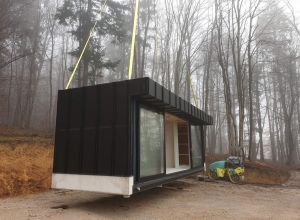
RMB module
As we can see, the world of prefabricated construction is diverse, and providers can be differentiated by several key variables. These include whether they offer predesigned or custom-built models, their use of 2D panels versus 3D volumetric modules, and their approach to construction, which can be fully off-site or a mix of off-site and on-site work. Additionally, companies are distinguished by other factors like their distribution reach (regional vs. international), their primary construction system (such as timber frame, CLT, steel, or concrete), and whether they specialise in residential or specific-purpose buildings like hospitality.
So, How Many Prefab House Manufacturers Are in Europe Today?
For this analysis, we define prefab house manufacturers as companies that produce factory-made structural elements that can be assembled both off-site or on-site to build residential buildings (panelized, modular, CLT, steel, or log/kit homes).
This is, excluding prefab home providers that advertise them as producers but are pure distributors, contractors without factories, and non-residential prefab makers.
Estimated number of manufacturers in Europe:
Based on industry directories, national associations and cross-checked with an intensive on-field research, there are currently over 1,000 prefab house manufacturers across Europe.
Europages lists 1,576 suppliers in the “prefabricated houses” category and, crucially, 858 tagged as “Manufacturer/Producer.” The supplier-country breakdown is led by Germany (347), Spain (86), Romania (30) and the Baltic countries (Latvia, Estonia and Lithuania: 39). Nevertheless, this figure of 858 isn’t the most reliable Europe-wide count of actual producers, as the aggregator often conflates actual manufacturers with other roles, such as dealers and service firms.
A strikingly different picture emerges when examining national industry associations, which collectively count fewer than 400 members across Europe. Domestic industry associations provide very limited visibility, with few companies formally registered as members across Europe:
- Austria: the ÖFV lists 16 manufacturer members on its “Mitglieder – Hersteller” page.
- Bulgaria: The Bulgarian Union of the Producers of Prefabricated Houses, lists 13 full members.
- Czech Republic: The Association of Suppliers of Assembly Houses lists 26 construction companies.
- Estonia: Woodhouse, the Estonian Wooden Houses Cluster lists 27 house manufacturers.
- Finland: The Finnish Association for Manufacturers of Prefabricated Houses (Pientaloteollisuus) regroups 11 full member companies that cover approximately half of the prefabricated house industry.
- Germany: the BDF (Bundesverband Deutscher Fertigbau) says it’s a union of 49 house manufacturers in timber prefab.
- Ireland: ITFMA, the Irish Timber Frame Manufacturers Association regroups 17 members.
- Italy: The Italian Association of Wooden Premanufactured Houses (Lignius) includes 21 timber prefab manufacturers.
- Slovakia: The Association of Wood Processing Manufacturers of the Slovak Republic stands out as one of the most active, bringing together 31 member companies.
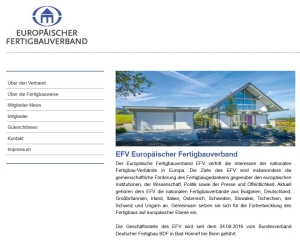
Spassio has maintained a continuous review of the prefabricated industry across Europe and the United Kingdom since 2020. This comprehensive effort has so far led to identify over 1,200 prefab house manufacturers, excluding dealers and service firms.
Here is the breakdown of these manufacturers among the principal producing countries:
| #Manufacturers | |
| Germany | 121 |
| Estonia | 102 |
| Latvia | 96 |
| Lithuania | 89 |
| Netherlands | 79 |
| Spain | 75 |
| United Kingdom | 74 |
| France | 74 |
| Poland | 65 |
| Austria | 31 |
| Italy | 29 |
| Belgium | 19 |
Regional trends:
- The Baltics and Poland are export-driven, supplying much of Western Europe.
- Germany and Austria are European leaders in prefab timber construction.
- Scandinavia has some of the highest adoption rates, with prefab accounting for over 90% of new builds.
- Southern Europe (Spain, Italy, Portugal) is catching up as prefab overcomes cultural and regulatory barriers.
In total, Europe’s prefab industry is both fragmented and growing, reflecting diverse regional building traditions and market demands.
How to Find a Trusted Prefab House Provider
While the numbers are impressive, buyers face a challenge: it’s not easy to know the reliability of the supplier behind a nice image. In the digital age, slick websites and photorealistic renderings often mask companies with no real manufacturing capacity.
Determining which of the hundreds of prefabricated providers is the right fit for your project can be a demanding and time-consuming journey. It requires a significant amount of research and due diligence, often leaving you with a sense of risk and uncertainty about the final result.
To help you navigate this process, here are some of the factors and questions you will probably consider when searching for and selecting the right provider.
Is it really a manufacturer or a reseller? — Who actually builds the house?
Transparency of contracts — Who receives your deposit? Is there escrow protection?
Is the company stable financially? — Does it have the capital to handle projects?
What’s their track record? — How many homes have they built? Any verifiable case studies close to you?
Regulatory compliance — Are their homes certified for your country’s building codes?
Warranty & guarantees — Do they go beyond minimum legal coverage?
Customer reviews — Are there independent, verified testimonials?
After-sales service — Do they provide support for maintenance or defects?
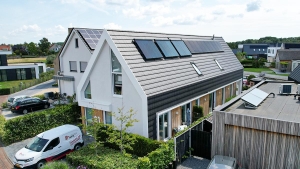
Get quotes for your prefab project
Take 5 minutes to complete our form and receive quotes from our network of prefab suppliers. It's free, quick, and easy.
ASK FOR QUOTESPractical tips:
- Visit the factory if possible — seeing production lines firsthand is the best guarantee of credibility.
- Check local associations (e.g., BDF in Germany, ÖFV in Austria).
- Ask for references from past clients.
Red flags to avoid:
- Providers that demand large upfront deposits without clear contracts.
- Companies with no factory visits possible.
- Websites that only showcase 3D renders but no real photos of built projects.
- Recently formed companies with no corporate history.
For such a significant investment — often requiring a 30–40% down payment — due diligence is not optional. Behind a glossy photo may lie very different realities of manufacturing capacity and financial stability, which is why seeking advice from an industry expert is strongly recommended.
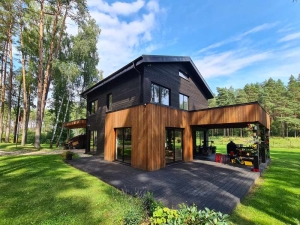
Conclusion
Prefabricated housing in Europe has evolved from a marginal solution into a mainstream, industrialized alternative to traditional construction. Today, with more than 1,000 manufacturers active across the continent, buyers and developers enjoy more choice than ever before.
For homeowners and investors alike, the message is clear—prefab housing is no longer a niche solution, but a defining force in Europe’s housing future.
Yet with that choice comes complexity: the market is fragmented, with companies ranging from highly specialized builders to resellers and digital marketers with limited capacity. This diversity makes due diligence essential for anyone looking to purchase a prefab home.
If you are considering a prefab home, take the time to research providers carefully, verify their manufacturing capabilities, and understand the system they use. The right partner will not only build you a house but deliver a home that is sustainable, cost-efficient, and future-proof.

